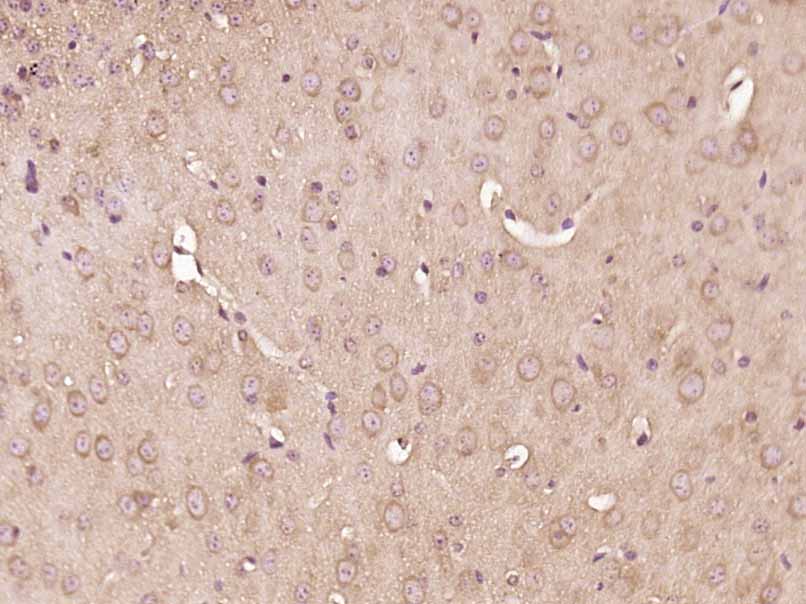
Rabbit Anti-RAB10 antibody
GTP binding protein RAB10; Rab 10; Rab-10; RAB10 member RAS oncogene family; RAB10_HUMAN; Ras related GTP binding protein; Ras related GTP binding protein RAB10; Ras-related protein Rab-10.
View History [Clear]
Details
Product Name RAB10 Chinese Name G蛋白Binding proteinRAB10抗体 Alias GTP binding protein RAB10; Rab 10; Rab-10; RAB10 member RAS oncogene family; RAB10_HUMAN; Ras related GTP binding protein; Ras related GTP binding protein RAB10; Ras-related protein Rab-10. Research Area Signal transduction G protein-coupled receptor G protein signal Immunogen Species Rabbit Clonality Polyclonal React Species Mouse, (predicted: Human, Rat, Chicken, Dog, Sheep, ) Applications WB=1:500-2000 ELISA=1:5000-10000 IHC-P=1:100-500 IHC-F=1:100-500 ICC=1:100-500 IF=1:100-500 (Paraffin sections need antigen repair)
not yet tested in other applications.
optimal dilutions/concentrations should be determined by the end user.Theoretical molecular weight 23kDa Cellular localization cytoplasmic The cell membrane Form Liquid Concentration 1mg/ml immunogen KLH conjugated synthetic peptide derived from human RAB10: 41-140/200 Lsotype IgG Purification affinity purified by Protein A Buffer Solution 0.01M TBS(pH7.4) with 1% BSA, 0.03% Proclin300 and 50% Glycerol. Storage Shipped at 4℃. Store at -20 °C for one year. Avoid repeated freeze/thaw cycles. Attention This product as supplied is intended for research use only, not for use in human, therapeutic or diagnostic applications. PubMed PubMed Product Detail The Ras-related superfamily of guanine nucleotide binding proteins, which includes the Ral/Rec, Rap, R-Ras, and Rho/Rab subfamilies, exhibit 30-60% homology with Ras p21 (1). Accumulating data suggests an important role for Rab proteins, either in endocytosis or in biosynthetic protein transport (1,2). The transport of newly synthesized proteins from the endoplasmic reticulum to various stacks of the Golgi complex and to secretory vesicles involves at each stage the movement of carrier vesicles, a process that appears to involve Rab protein function (1-6). The possibility that Rab proteins might also direct the exocytosis from secretory vesicles to the plasma membrane is supported by the observation that in yeast, the SEC4 protein, which is 40% homologous to Rab proteins, is associated with secretory vesicles (9). Several members of the Rab subfamily have been identified, each of which is found at a particular stage of a membrane transport pathway (3-8).
Function:
The small GTPases Rab are key regulators ofintracellular membrane trafficking, from the formation of transportvesicles to their fusion with membranes. Rabs cycle between aninactive GDP-bound form and an active GTP-bound form that is ableto recruit to membranes different set of downstream effectorsdirectly responsible for vesicle formation, movement, tethering andfusion (By similarity). That Rab is mainly involved in thebiosynthetic transport of proteins from the Golgi to the plasmamembrane. Regulates, for instance, SLC2A4/GLUT4 glucosetransporter-enriched vesicles delivery to the plasma membrane. Inparallel, it regulates the transport of TLR4, a toll-like receptorto the plasma membrane and therefore may be important for innateimmune response. Plays also a specific role in asymmetric proteintransport to the plasma membrane within the polarized neuron andepithelial cells. In neurons, it is involved in axonogenesisthrough regulation of vesicular membrane trafficking toward theaxonal plasma membrane while in epithelial cells, it regulatestransport from the Golgi to the basolateral membrane. Moreover, mayplay a role in the basolateral recycling pathway and in phagosomematuration. According to PubMed:23263280, may play a role inendoplasmic reticulum dynamics and morphology controllingtubulation along microtubules and tubules fusion. [ENZYME REGULATION] Rab activation is generally mediated by aguanine exchange factor (GEF), while inactivation throughhydrolysis of bound GTP is catalyzed by a GTPase activating protein(GAP) (By similarity). That Rab is activated by the DENND4C guanineexchange factor (GEF).
Subunit:
Interacts with MYO5A; mediates the transport to theplasma membrane of SLC2A4/GLUT4 storage vesicles. Interacts withGDI1 and maybe with GDI2; negatively regulates RAB10 associationwith membranes and activation. Interacts (GDP-bound form) withLLGL1; the interaction is direct and promotes RAB10 associationwith membranes and activation through competition with the Rabinhibitor GDI1 (By similarity). Interacts with EXOC4; probablyassociates with the exocyst (By similarity).
Subcellular Location:
Cytoplasmic vesicle membrane; Lipid-anchor(Probable); Cytoplasmic side (Probable). Golgi apparatus,trans-Golgi network membrane (By similarity). Endosome membrane.Recycling endosome membrane. Cytoplasmic vesicle, phagosomemembrane (By similarity). Cell projection, cilium. Endoplasmicreticulum membrane. Note=Associates with SLC2A4/GLUT4 storagevesicles. Localizes to the base of the cilium. Transientlyassociates with phagosomes (By similarity). According toPubMed:23263280 localizes to the endoplasmic reticulum at domainsof new tubule growth.
DISEASE:
Belongs to the small GTPase superfamily. Rab family.
Similarity:
Belongs to the small GTPase superfamily. Rab family.
SWISS:
P61026
Gene ID:
10890
Database links:Entrez Gene: 421994 Chicken
Entrez Gene: 19325 Mouse
SwissProt: P61027 Mouse
Unigene: 378993 Mouse
Unigene: 486858 Mouse
Unigene: 65864 Rat
Product Picture
Bought notes(bought amounts latest0)
No one bought this product
User Comment(Total0User Comment Num)
- No comment



 +86 571 56623320
+86 571 56623320
 +86 18668110335
+86 18668110335

